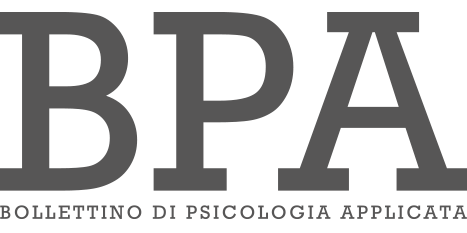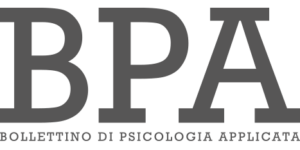- Home
- Advice for authors
Advice for authors
Advice for authors
Applied Psychology Bulletin Bollettino di Psicologia Applicata publishes scientific contributions in English, concerning methodology and research outcomes in the applied psychology various fields. Each annual volume consists of three regular issues. Only papers that have not been previously published or submitted elsewhere can be considered for publication. Submitted manuscripts are subject to peer review and may be returned to authors for revision. The journal contains the following main sections: Reviews (of a broader field or topical context), Research and Experiences and Tools. Papers should be submitted via web at https://bpa.giuntipsy.com. If you need to contact the editorial board you can use this address: bpa@giuntipsy.com.
Copyright
By submitting an article, the author confirms and guarantees on behalf of him/herself and any coauthors the following: the manuscript has not been submitted or published elsewhere; that he or she owns all copyright and titles to the submitted contribution including any figures, photographs, line drawings, plans, maps, sketches, and tables; the article and its contents do not infringe in any way on the rights of third parties. Upon acceptance of the article for publication, the author agrees to transfer to the publisher the exclusive right to reproduce and distribute the article and its contents, in both physical and non-physical, electronic, and/or other forms. These rights are transferred for the duration of copyright as defined by international law. Authors will be asked to complete, sign and return a Copyright Agreement form upon acceptance of their article.
Title page
The title page of each paper or article should include, in the following order: title of the article; author’s name(s) preceded by first names, but with no academic titles mentioned; name of the institute or clinic (if there is more than one author or institution, affiliations should be indicated using superscript Arabic numerals); an address for correspondence (including the name of the corresponding author with e-mail and phone number).
Summary and keywords
Papers for sections Research and Experiences and Tools must be provided with a summary in English (total length should be approximately 250 words for Research and 150 words for Experiences and Tools), and must be articulated as follows: “Introduction” (presentation of the main topic and the study’s aims), “Methods” (description of sources, sample, study design, measures and data analysis), “Results” (report of relevant outcomes) and “Conclusions” (study’s implications and future research paths). As far as Reviews are concerned, the summary (approximately 100 words total) must contains article’s topic, goals and theoretical assumption (general or specific), literature reviewed and conclusions. A maximum of 3 keywords should also be given (please refer to the Thesaurus of Psychological Index Terms).
References
Reference citations in the text and in the bibliography should basically follow conventions listed in the Publication Manual of the American Psychological Association (4th ed.).
For example:
KLOPFER, E. & DAVIDSON, H.H. (1962). The Rorschach technique: An introductory manual. San Diego: Harcourt Brace Jovanovich (it. tr.: La tecnica Rorschach: Un manuale introduttivo. 1971, Firenze: Giunti O.S. Organizzazioni Speciali).
McREYNOLDS, P. (1986). History and assessment in clinical and educational settings. In R.O. Nelson e S.C. Hayes (ed.), Conceptual foundations of behavioral assessment. New York: Guilford Press.
RIZZO, J.R., HOUSE, R.J. & LIRTZMAN, S.I. (1970). Role conflict and ambiguity in complex organizations. Administrative Science Quarterly, 15 (1), 150-163.
Tables and figures
Tables and figures should be numbered using Arabic numerals and must be cited in the text (e.g., “As shown in Table 1, …”). Below the table/figure number, a brief descriptive title should be given; this should then be followed by the body of the table/figure. It is recommended that each table/figure should also include a brief explanatory legend, if needed. Tables and figures etc. should be sent as separate files. However, upon acceptance of an article, it may be necessary for figures to be supplied separately in a form suitable for better reproduction: preferably high-resolution (300 dpi) or vector graphics files. Where this is necessary, the corresponding author will be notified by the editors. Figures will normally be reproduced in black and white only. While it is possible to reproduce color illustrations, authors are reminded that they will be invoiced for the extra costs involved. If figures or tables are taken from another source, a letter from the respective copyright holders granting permission to reproduce them must be submitted with the paper.
Length of articles
Reviews and Research should not exceed ca. 9-10 printed pages, i.e., ca. 7500 words of main text plus ca. 40 references (not including summary and title page; if figures or tables are included, the word count should be adjusted accordingly). Experiences and Tools should not exceed ca. 4-5 printed pages, i.e., ca. 3500 words plus up to 15 references.
Scientific nomenclature and style
Authors should follow the guidelines of the APA manual regarding style and nomenclature. Papers that do not conform to these guidelines may have to be returned to the authors for correction.
Language
It is recommended that authors who are not native English speakers have their papers checked and corrected by a native-speaker colleague before submission. Editors may have to return manuscripts for correction if the English is inadequate. Standard US American spelling and punctuation as given in Webster’s New Collegiate Dictionary should be followed.
Proofs
If requested, proofs will be sent to the corresponding author. Content changes or stylistic changes may only be made in exceptional cases in the proofs. Corrections that exceed 5% of the typesetting costs may be invoiced to the authors.
Off-prints
Complimentary PDF off-prints will be sent to the corresponding author.


